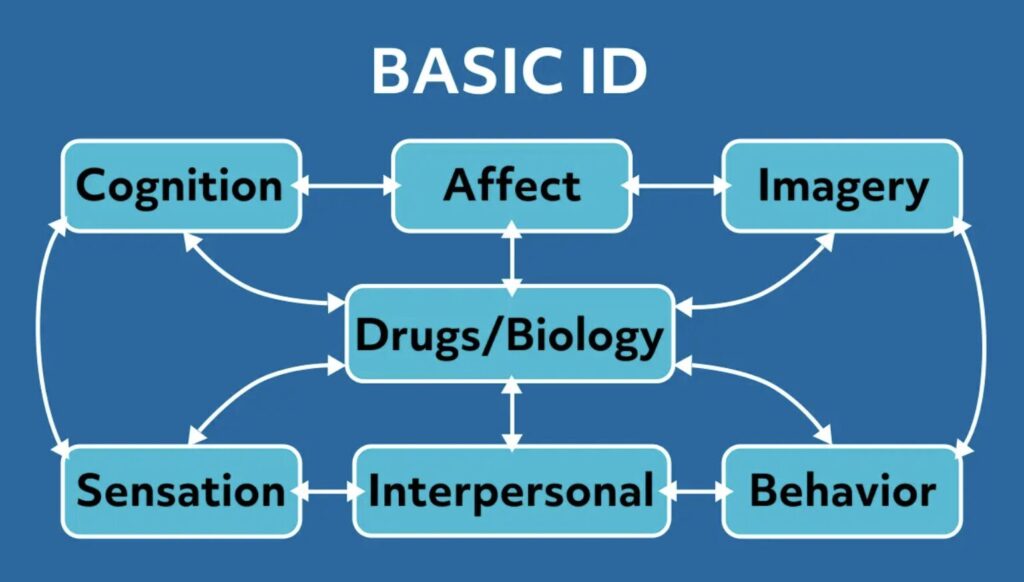
In today’s therapeutic landscape, many approaches focus on one aspect of human experience—thoughts, emotions, or behaviors—often in isolation. But what if you’re more complex than that? Arnold Lazarus’s BASIC‑ID, the foundation of his Multimodal Therapy, offers a richer, more integrative way to understand and treat psychological challenges.
What Is BASIC‑ID?
Lazarus (1981) proposed that personality and mental health are best understood through seven interacting modalities:
- Behavior
- Affect (emotions)
- Sensation (physical experiences)
- Imagery (mental pictures)
- Cognition (thoughts and beliefs)
- Interpersonal relationships
- Drugs/Biology (including health factors such as sleep, nutrition, and medication)
This framework encourages therapists to evaluate and intervene across all these domains rather than focusing narrowly on one (Lazarus, 1981; Lazarus, 1989).
Why BASIC‑ID Works: A Therapist’s Versatile Toolkit
Lazarus (1981) emphasized that change in one modality often ripples into others, making treatment more comprehensive and effective. Therapists use “tracking” to identify which modalities are most problematic and “bridging” to connect interventions across modalities, allowing for individualized treatment tailored to the client’s unique profile (Lazarus, 1989).
This approach is especially valuable for clients whose difficulties span multiple domains—for example, those with intertwined emotional distress, cognitive distortions, physiological symptoms, and interpersonal issues (Nezu, Nezu, & Lombardo, 2004).
Recent Research Supporting BASIC‑ID
Recent studies have continued to explore and validate the effectiveness of Multimodal Therapy:
- Adaptations for Children and Adolescents: Research has shown that Multimodal Therapy can be effectively adapted for younger populations, addressing issues such as anxiety, ADHD, and behavioral problems (Keats, 1979; Springer, 2007).
- Integration with Other Therapeutic Approaches: Studies have demonstrated that integrating Multimodal Therapy with other therapeutic modalities, such as cognitive-behavioral therapy, can enhance treatment outcomes for various psychological disorders (Springer, 2007).
- Empirical Support for Multimodal Interventions: Research has provided empirical support for the use of multimodal interventions in treating complex psychological issues, highlighting the importance of addressing multiple dimensions of a client’s experience (Nezu et al., 2004).
Best Fit For…?
- Depression and Anxiety: BASIC‑ID allows integrated treatment of emotional dysregulation, negative cognitions, somatic complaints, and social withdrawal (Nezu et al., 2004).
- Stress and Trauma: Addressing imagery, physiological sensations, and interpersonal disruptions together fosters healing in trauma survivors (Lazarus, 1981).
- Behavioral and Lifestyle Problems: By incorporating biological and interpersonal factors, BASIC‑ID supports sustainable behavior change in issues like addiction, sleep disturbances, or chronic illness management (Nezu et al., 2004).
In Lazarus’s Own Words
Lazarus (1981) argued that narrow interventions often yield short-term relief but fail to prevent relapse. BASIC‑ID was designed to broaden therapeutic focus, ensuring no key element of the person’s experience is overlooked, thereby promoting durable, holistic change.
Daisy Clinic Therapy & Counseling Perspective
At Daisy Clinic, we find Arnold Lazarus’s BASIC‑ID framework highly valuable for tailoring treatment plans that truly fit the whole person. Many clients come to us with complex, multifaceted challenges—such as anxiety co-occurring with sleep issues and interpersonal difficulties—which require more than a one-dimensional approach.
By assessing and working across the seven BASIC‑ID domains, our therapists can craft flexible, integrated interventions that address the unique mix of behaviors, thoughts, emotions, sensations, and biological factors each client presents. This often leads to faster breakthroughs and more sustainable progress, especially for those who have struggled with more narrowly focused therapies.
BASIC‑ID’s versatility also helps our team collaborate effectively across disciplines, ensuring that mental health care at Daisy Clinic incorporates physical health, lifestyle, and social context, truly reflecting a biopsychosocial model. For clients facing complex or chronic conditions, this approach fosters resilience and lasting change.
Bottom Line
Arnold Lazarus’s BASIC‑ID is a flexible, evidence-informed model that treats the whole person, not just isolated symptoms. Its multidimensional scope makes it especially effective for complex mental health challenges requiring personalized, integrative care.
References
Keats, D. B. (1979). Multimodal therapy with children. Pergamon Press.
Lazarus, A. A. (1981). Multimodal behavior therapy. Springer Publishing Company.
Lazarus, A. A. (1989). Multimodal therapy: Techniques and guidelines. Wiley.
Nezu, A. M., Nezu, C. M., & Lombardo, E. R. (2004). Cognitive-behavioral case formulation and treatment design: A problem-solving approach. Springer Publishing Company.
Springer, D. W. (2007). Multimodal therapy: A unifying approach to psychotherapy. In L. S. Greenberg & J. C. Muran (Eds.), Handbook of psychotherapy integration (pp. 125–143). Oxford University Press.